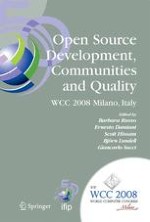We are very pleased to introduce Open Source Development, Communities and Quality. The International Conference on Open Source Systems has come to its fourth edition – OSS 2008. Now, Free, Libre, and Open Source software is by all means now one of the most relevant subjects of study in several disciplines, ranging from information technology to social sciences and including also law, business, and political sciences. There are several conference tracks devoted to open source software with several publications appearing in high quality journals and magazines. OSS 2008 has been organized with the purpose of being the reference venue for those working in this area, being the most prominent conference in this area. For this th reason OSS 2008 has been located within the frameworks of the 20 World Computer Congress, WCC 2008, in Milan, the largest event of IFIP in 2008. We believe that this conference series, and the IFIP working group it represents, can play an important role in meeting these challenges, and hope that this book will become a valuable contribution to the open source body of research.
